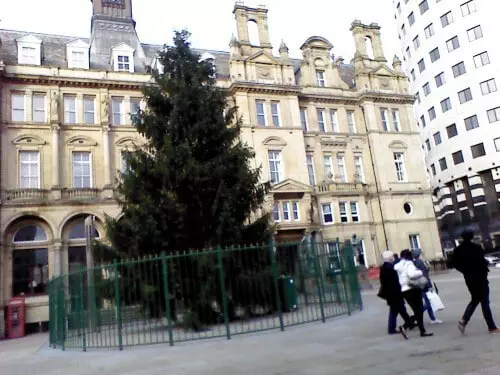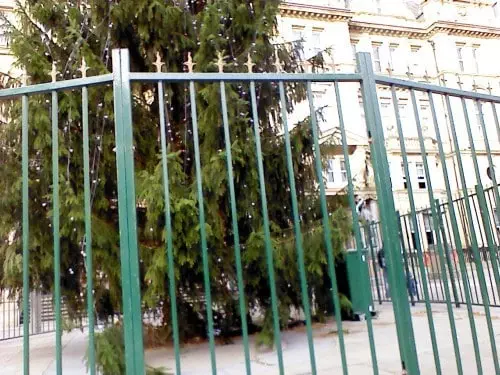I often feel the city I live in is being designed by Mr Wiggins from Ironside and Malone:
A recent post on Leeds List lauding Leeds’s vibrant future – while I am at it, anyone submitting a contribution to this site containing any combination of the words “Leeds” and “vibrant” shall be mocked, mercilessly, then I’ll track you down and thump you – was illustrated by a picture of Bridgewater Place.

This is a building that locals call “The Dalek”, and it is regarded around here with as much warmth and fondness as an invading intergalactic exterminator. The only thing “vibrant” about Bridgewater Place is the wind whipping around your ears. Check the litter bins – they are a brolly graveyard. Bridgewater Place is an “iconic” building, regularly featured in corporate marketing photos – it’s also incomparably ugly, arrogant, ludicrous, and has absolutely no genuine ties to the place it has been plonked in. Leeds need less of that.
The City Talking the other day had a good news piece on the Lumiere development, another “iconic building” featuring “a dramatic ten storey high glass wall” No doubt it’ll be vibrant too. And also completely irrelevant to the majority of us who live in and love the city, just “edifice architecture” as one critic calls it.
Iconic buildings don’t make a city. And, sorry Trinity Leeds and Leeds Arena, but neither do big private developments, no matter how nice and cuddly they are – they are still a suburban phenomena allowed to encroach on the city.
A city – a real city – is all about it’s public space. The space between buildings. The place where we meet and talk and mingle freely. It’s where ideas happen and creative collaborations begin – and I don’t know how many books I’ve read this year pointing out the simple fact that a city’s success depends upon the vitality of its public real. So, Leeds, Let’s forget the irrelevant iconic nonsense and look at our public realm.
Have you walked out of the train station this week? I love City Square. And our Christmas tree – I have got a personal connection to the history of the City Square tree as my dad used to bring it to Leeds on his lorry, and I occasionally went with him to get it when I was a kid – so it’s actually painful to see this.
Yes, I know that 99.99% of us can cope with a big Christmas tree with giant baubles and huge lights and not feel the need to interfere, molest or damage it in any way. But to allow for the occasional drunken dickhead we have to put the poor tree behind bars? This is our city square, we should be showing our best as a city here … I’m not sure those barriers do much for my civic pride. To me it just looks like those in charge don’t trust the rest of us to look after our own city. It’s the sort of fence you put around derelict land to stop children getting into bother (look at the back of Temple Works, you’ll get what I mean.) And we have so much design talent in Leeds, couldn’t we have a competition or something to come up with the most graceful, attractive and useful solution to the problem of (very occasional) vandalism? I don’t feel like I want to walk visitors to my city past a pine tree penitentiary.
And then this. I went to look at this again after a Twitter conversation with @_jonb and I had hopes for the place. It used to be shabby. It was really badly designed. It was hopelessly messy. But it was always used … look at it now.
I took these pics midday, while the Abbey Dash people were thronging through Leeds. The space is seconds from the station. People were walking by. Tired people. People looking for somewhere to sit and while away a bit of time talking about what just happened. Why weren’t they here?
It’s sunny, quite warm for the time of year, and there are 4 or 5 coffee shops within 30 seconds walk – this should be a place people want to be.
Before the place got redeveloped there were seven or eight fixed tables here, not ideal but made of thin, mesh-like steel that didn’t retain rain and heated up reasonably quickly. And it didn’t feel you had to wear a wispy beard and ride a single-geared bike to be here. The place was always used. And I think these were the only free tables in Leeds? I came here loads, and I liked it. People talked to each other. They managed to make it convivial.
I can’t imagine wanting to be here now. Clean, cold, clinical marble, straight lines, hard steel, harsh colours that don’t absorb the sunlight … it’s like it was designed to rid the place of any street culture it may have once had.
I’m sure it’s easier to police, clean, control now … but that’s mainly because we’ve managed to rid the city centre of yet one more genuinely habitable spot of public space. Nobody wants to be there, so of course it’s better, and much easier to maintain from a management point of view.
So I’m a bit sad really. Sad that the majority of Leeds websites seem to be mesmerised by the shiny, happy, pointless crap that really doesn’t do the city any good. And sad that the places that are genuinely convivial and really make the most contribution to the city are ignored in favour of more perfume bottle architecture.
Tomorrow there’s a film at Leeds Film Festival about Jan Gehl. To be honest he’s the one who got me thinking about cities and architecture and public space years ago. The Culture Vulture is offering two for one tickets. Would be good to see you there if you give a monkeys about this sort of stuff. Book a ticket, come and argue with me in the bar after.







Bridgewater Place is the worse thing architecturally to happen to Leeds in years, never mind the aesthetics of it, the building is directly responsible for killing a man. How it ever got built without proper wind tests is criminal.
The spaces between buildings for the public to use is vital for a city to work and Leeds could do a lot better in this area. Iconic buildings don’t make a city but they can help “sell it” and generate income to improve other areas.
One person’s view of “iconic” architecture is always subject to opinion and often differs to others. Right or wrong cities often use their latest modern building in marketing their city. Who would have ever planned to go to Bilbao before the Guggenheim was build there, the architecture for it put the city in the public attention world wide and has helped regenerate the city.
Personally I think the new Arena & Trinity are good additions to the cities fabric and serve as excellent examples of their building uses whether you are into shopping & music and so using the buildings is another point.
I am however waiting with great anticipation to what will come of the “city park” planned for The Tetley site.
Bridgewater Place looks like it was designed on an etch-a-sketch by a 12 yr old with a Dr Who obsession. I hate that Leeds is identified with a building so bad.
And yes, the Guggenheim is great, but for every Frank Gehry hit there’s a National Centre for Popular Music … remember that? Of course you don’t. Iconic failure.
I think Trinity have done a good job with the paths around the place – except for the truly terrible public seating – but the goods entrance on Boar Lane needs to be looked at again. It’s confusing. But both Trinity and Arena feel “out of town” to me.
Your embargo on the word “vibrant” is noted though I plead guilty to having employed it in the past (and can’t make firm promises about the future); it’s something about the strong onomatopoeic timbre of the constituent letters, especially if you permit a slight roll to the “r” and then allow a full enunciation of the closing “t”. There are places where it is absolutely the mot juste but I concur that coupled to Leeds (a lively and effervescent city) may not be one of them. And talking of words which SHOULD be disallowed, may I nominate “iconic”.
Agree about public spaces (and how their conviviality can be crushed by misguided “cleaning up”) but there are some shockers in their own right. There is no more dismal space on the face of this earth than Bradford’s “urban garden” (take a picnic). You write, “A city – a real city – is all about its public space. The space between buildings.” It is impossible not to mention buildings even when effusing about the spaces in between.
Buildings are part of a city’s clothing too and, ideally, should enhance the public space, should be considered symbiotically with it. And of course there are sometimes buildings that are just so beautiful that if they were human, you would want to cuddle them. Agreed that Bridgewater is not one such (probably only its mother could love it). However…
A vibrant and iconic (writer assumes protective armour) development in Leeds is the gorgeously patinated series of buildings put up by the Leeds Metropolitan University around the old Broadcasting House. They are worthy of our hosannas. And I have spied the city’s jeunesse doree congregating happily on the open space in their lee around that daft marooned barge.
What a stuff of un-ambiguity and preserveness of valuable know-how
regarding unpredicted feelings.